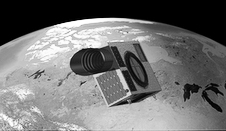A small Canadian satellite was launched 800 kilometres into space Feb. 25, which researchers at the University of Calgary are hoping will discover and further examine asteroids.
The Near-Earth Object Surveillance Satellite (NEOSSat) is the first of its kind specifically designed to monitor asteroids orbiting between the Earth and the sun.
The $25 million spacecraft is approximately the size of a suitcase and circles the globe every 100 minutes 24 hours a day, according to the university. The Canadian Space Agency (CSA) will send the images and information captured by the NEOSSat to the geoscience department at UCalgary to be further analyzed.
“The software suite itself is the most computationally intensive moving object detection algorithm ever deployed for asteroid detection,” according to Rob Cardinal, a research associate at UCalgary who developed the software system for the NEOSSat.
“The system that is in place has been under continuous development for about nine years,” Cardinal said.
“During development and testing, the software has already discovered two comets and one near-earth asteroid,” he said. “The comets . . . were discovered using early versions of the software, along with [the] asteroid . . . which is a fairly large object in a highly inclined orbit.”
Cardinal said he developed most of the software himself but some of the moving object detection software was developed in collaboration with NASA.
Rachel Zimmerman Brachman, who works at the Jet Propulsion Labratories (JPL), a NASA centre in California, confirmed that JPL “is indeed working on a project to send humans to an asteroid.”
Having worked for both the CSA and NASA, Brachman said both organizations have worked in collaboration with universities before, UCalgary being one of them.
“Both NASA and the CSA work with university partners to pursue space exploration research,” Brachman said via email. “NASA has many summer internship opportunities for students, to give students hands-on experience and advance their STEM [science, technology, engineering, and mathematics] careers.”
Margaret Campbell-Brown, an associate professor at Western University and a member of the Western Meteor Physics Group, said the development of the NEOSSat will “fill in the nature of the near-earth population,” and allow researchers to “discover asteroids that are close to the sun.”
The Russian fireball, the 15-metre meteor that hit central Russia two weeks ago, has sparked interest in astronomical research, Campbell-Brown said.
She noted that researchers were unaware of this meteor because it came from the direction of the sun, the exact area UCalgary’s satellite is now orbiting.
“It’ll expand our ability to see these things before they hit us,” Campbell-Brown said.
“The best chance for preventing anything is if we catch them early,” she said. “It’s for our own advantage to understand our area in space because this is where we live and it can obviously significantly impact our lives.”






